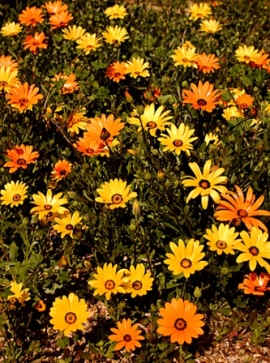Dimorphotheca are members of the large Asteraceae family, which includes asters, daisies, and sunflowers, and their daisy-like flowers will attract butterflies to your garden. They come in the traditional bright orange and yellow flowers as well as many pastel shades and pure white.
The African Daisy is used as low cover around shrubs or as the focal point in mass plantings. They also make beautiful borders, so sow them in mass into large borders, beds and rockeries for hassle-free winter and spring colour. These sun lovers will only open their petals in sunlight and remain steadfastly closed at night or on overcast days.
![]() Cultivation/Propagation:
Cultivation/Propagation:
These easy to grow winter annuals are sown directly into garden beds in full sun in autumn, when the daytime temperatures are between 18 to 22°C. They grow quickly to about 35cm tall and 30cm wide, and are hardy to severe frost and even drought, but will perform better if watered moderately, especially in the summer rainfall regions.
Sow them into light, well-drained soil. Sprinkle the seeds thinly and cover with about 2cm of soil and rake in lightly. Keep the soil moist until the seeds germinate, and when the young plants are a few centimetres tall, thin them out if necessary.
African Daisies will take 10 to 14 days to germinate, and about 3 months to flower from seed.
When the plants die down in early summer; collect the seeds to sow next season.
![]() Pests & Diseases:
Pests & Diseases:
As the weather warms up in spring, aphids can become a problem. They can be treated with insecticidal soap.
Cape marigolds are also vulnerable to fungal diseases if the leaves and flowers get wet. To help prevent this, ensure that the plants have good air flow around their leaves by thinning out the seedlings to the correct distance apart to avoid overcrowding.
Warning:
All parts of the plant are poisonous if ingested.



